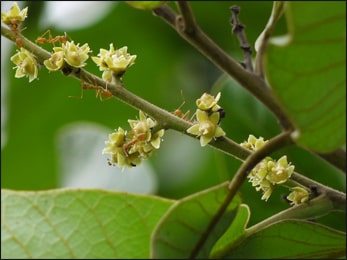Bhallataka, Marking Nut (Semecarpus anacardium)

Description of plant
It is medium to large sized deciduous tree with grey bark exfoliating in small irregular flakes, 15-25mt in height and closely related to cashew. Leaves are simple alternate, oblong, rounded at apex glabrous above and pubescent beneath. Flowers appear in panicles greenish white in color appears in May and June. Nut of this plant is smooth, ovoid, lustrous black about 2.5cm long. Fruits ripen from December to March. Seeds inside the black fruit is called godambi, is edible when prepared properly. Fruits of this tree are also used for dye.
General information
Bhallataka, geeru beeja and marking nut is common name of Semecarpus anacardium. Washer men used this herb to mark clothes before washing. This versatile herb is used in ayurvedic system to cure various diseases by pacifying kapha dosha in human body. Red-orange part of Bhallataka fruit is collected, sun dried and used for medicinal purpose. This herb is considered good for both male and female reproductive system. Its nut contains various active compounds such as bioflavonoids, phenolic acid, bhilawanols, minerals, vitamins and amino acids. This herb is anti-inflammatory, anti-oxidant, anti-microbial, anti-reproductive, CNS stimulant, hypoglycemic, anti-cancerous and hair growth promoter.
Special note about Semecarpus anacardium
Bhallataka shodhana - Bhallataka is highly toxic herb, direct exposure may cause boils on skin. Bhallataka purification (shodhana) is necessary to reduce the toxicity and hot potency of this herb. For this process ripe seeds are taken and put into water. Seeds which sink in water surface are taken for purification while others are discarded. Then seeds are cut into two pieces and immersed in brick powder. This dry brick absorb all the toxic oils from the seeds and make them usable for medicinal purposes.
Habitat
Semecarpus anacardium is moderate sized deciduous tree native to India easily found in outer Himalayas to Coromandel Coast. It is found in hotter parts of India up to 3500ft height. This plant is easily found in Assam, Bihar, Orissa, Chittagong, and Bengal. It is also found in western peninsula of East Archipelago and Northern Australia.
Classification
- Kingdom - Plantae
- Order - Sapindales
- Family - Anacardiaceae
Names
- Latin name - Semecarpus anacardium
- Common name - Marking nut, Geeru veej, Dhobi nut tree, Indian nut tree
- Sanskrit name - Angika, Agnimukh, Anala, Bhallataka, Arushkara
- Hindi name - Belatak, Bela, Bhilava
- Marathi name - Bhillava, Bhallataka, Bibba, Bibbu
- Tamil name - Kalakam, Kavaka , Senkotai
- Malayalam name - Alakcueer, Thennukota
- Telugu name - Bhallatamu
- Kannada name - Geru, Ger-kayi
- Oriya name - Bhollataki
- Urdu name - Baladur, Bhilavan
- Gujarati name - Bhilama
- Arabian name - Habvul kab
- French name - Anacardier D'orient
- Nepali name - Bhilai
- Spanish name - Anacardo
Ayurvedic Properties
| Hindi / Sanskrit | English | ||
| Rasa | Katu, Tikta, Kashaya | Taste | Pungent, Bitter, Astringent |
| Guna | Laghu, Tikshna, Snigdha | Physical Property | Light, Sharp, Uncutous |
| Virya | Ushna | Potency | Hot |
| Vipaka | Madhur | Metabolic Property (After Digestion) | Sweet |
Effects on Doshas
There is not any type of kapha imbalance which cannot be cured by this herb.
| Charak Samhita | Sushrut Samhita and vagbhata |
|
Nyagrodhadi gana, Mustadi gana |
Ancient verse about Semecarpus anacardium

According to above mentioned shalok arushak, arushkar, agnik, agnimukhi, bhalli, veervariksh and shofkrit all are synonyms of Bhallataka. Ripe fruit is sweet in taste after digestion, has sweet and bitter rasa, and helps in digestion, unctuous, sharp with hot potency. It helps in the breakdown of feces and induce purgation, improves intelligence and promotes digestion. It helps to cure vata - kapha dosha, wound, ulcers, ascites, skin disorders, piles, mal absorption, gaseous distention, inflammation, bloating, fever and worm infestation. Seeds are sweet, aphrodisiac, nutritious, balances vata and pitta dosha. Fruit cap is sweet, pacify pitta dosha, stimulate digestive fire and very beneficial for hair growth.
Practical uses of Semecarpus anacardium
- It's a common saying about this herb that there is not any kapha dosha disorder that cannot be treated by this versatile herb.
- This herb is appetizer and used to stimulate digestive system. It is good for improving digestion.
- Bhallatak is purgative in nature and used to induce purgation. It is very good for relieving constipation, digestive disorders, abdominal distention, ascites, piles and various types of worm infestation.
- The herb is best used to cure various skin related disorders such as skin rash, itching and swelling etc.
- It also acts as brain tonic, useful in brain weakness and used to improve intelligence.
- Bhallatak is a good expectorant and used to cure cough and asthma. Flowers of this plant are very beneficial for asthma.
- It is used to treat various nerve related disorders caused by vata dosha like sciatica, epilepsy, facial paralysis etc.
- Semecarpus anacardium is a cardiac stimulant, enhancer of white blood cells and used to cure cardiac debility.
- Bhallataka is good for both male and female reproductive systems, in women it stimulates uterus due to its hot potency. In men it is used for improving sperm count and sexual power.
Products from Semecarpus anacardium
- Sanjeevani vati
- Bhallataka oil
- Bhallataka kasheer
Doses
- Oil - 1-2 drops
- Awleha - ¼ - ½ tola
- Kasheer pak - 1-2 tola
Cautions
- Bhallataka in ayurvedic medicine is used after purification. Medicine should be taken under medical supervision and this herb should not be used as home remedy.
- Due to its hot potency it should not be used in extremely hot weather.
- It is best to be avoided by children, pregnant and lactating mothers.
- Fatal dose may lead to death within 12-24 hours.
- Excess use of Bhallataka may induce abortion in pregnant women.



